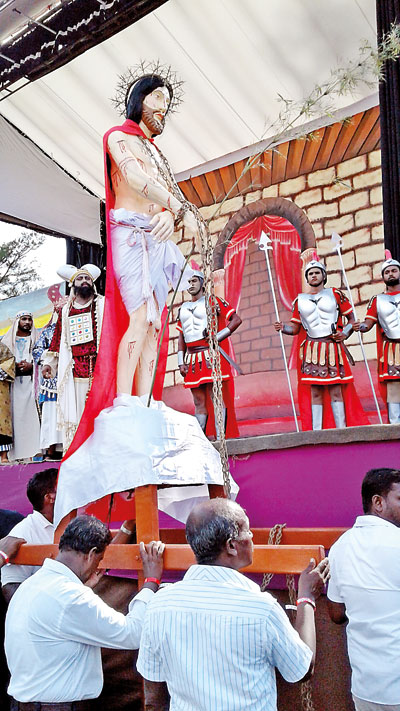News
The legend behind the Duwa passion play
The annual Passion Play at Duwa in Negombo was held on Good Friday this year as well.
Around 83 actors and three statues were used in this year’s event. The drama continues to draw huge audiences numbering several thousands of people.

Mestri's crucifixion of Jesus
The centre-piece of the passion-play has always been the miraculous statue of the crucified Christ, which was brought all the way from a small village in Cochin in India on 27 March 1838 by fisher folk from Duwa.
According to word-of-mouth tales, originally the people of Duwa used to hire a statue from the village of Pamunugama which was displayed at the passion play. Subsequently the people of Duwa felt they should have a similar statue of their own for the famed annual passion play.
The fisher folk who regularly purchase their fishing nets and other equipment from Cochin had noticed beautiful statues of the crucified Christ being carved in the Cochin area. Among them were three brothers -Mihindukulasuriya Juan Fernando,Mihindukulasuriya Duminga Fernando and Mihindukulasuriya Peduru Fernando who saw a range of beautiful statues of the crucified Christ turned out by master craftsman Jokinu Mestri.
The brothers resolved to have a statue especially turned out for the passion play held in Duwa and commissioned Jokinu Mestri to turn out one for the play at Duwa.
The statue took nine months to complete and a special team was sent to Cochin to bring the statue to Duwa. When the team arrived in Cochin, the sculptor advised them against taking the statue back immediately as the paint had not dried. He suggested not moving the statue until the paint was completely dry.
But the team members were insistent that the statue had to be used during that year’s passion play. Mestri Master is said to have carefully covered the statute in a shawl and tearfully bid it adieu, saying ‘my king is leaving us’.
However on reaching Duwa it was found shawl was stuck to the wet paint and the statue could not be used for that year’s drama.
The community attempted to bring Mestri to repaint the statue, but being too old to travel he sent his best pupil to repaint it.
It is said the pupil used a special mixture of paints prepared by Mesthri containing large quantities of gold to give the statue a glow that is visible to this day.
Legend has it that when Mestri’s
pupil returned to Cochin after completing his painting assignment, Mestri had already died.

